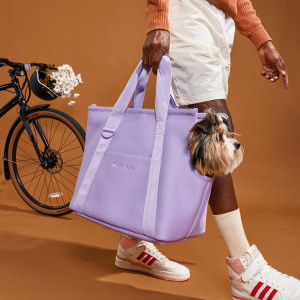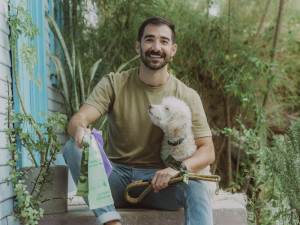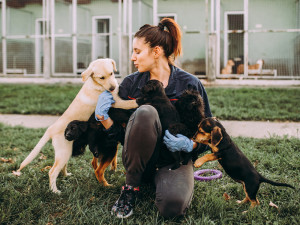3 Sustainability Reasons to Adopt Your Next Pet From a Shelter
If your New Year’s resolution is to go green, consider animal rescue.
It’s a new year, which means it’s time to reflect on what’s important to us — and what kind of choices we want to make in 2025. If helping animals and going green are both on your list of resolutions this year, adopting a pet from a shelter is a fantastic place to start.
When you choose to adopt rather than shop, you help your new pet and the earth — and, it goes without saying, bringing home a new best friend is great for you, too. Rescuing is a more sustainable route in a few key ways.
It reduces the resources needed to put more dogs and cats into the world.
You may be thinking, “The more dogs and cats, the merrier” — and of course, dogs and cats are so much more than the resources that go into creating them. But the reality is that so many animals in need of homes already exist. When you consider the fact that making new living things always has an environmental impact (be it the food needed to feed them or shelter needed to house them), you start to see the value of adopting an animal who’s already roaming the world versus paying a specialty breeder to create one.
“Getting a dog that already exists and is homeless is always the more sustainable solution,” says Dr. Erin Redmadopens in new tab, an assistant professor of Educational Sustainability at the University of Wisconsin-Stevens Point, who has fostered around 60 dogs in her lifetime.
How much do you spend on your pet per year?
To really understand why, Redman says to consider the downfalls of fast fashion and fashion trend culture. When certain styles are dubbed trendier than others in media and pop culture, we’re bound to constantly gravitate toward the hot new thing and do away with the old. We’ve seen what this throwaway mentality has done to our planet as far as the fashion industryopens in new tab is concerned, and it has a similar impact in the pet space.
The ASPCA estimatesopens in new tab that despite recent progress, 920,000 neglected animals are still killed in U.S. shelters every year. By adopting, we not only save these abandoned animals, but we save the resources that go into breeding, too.
It cuts down on unnecessary transportation.
A lesser-known significant sustainability perk of adopting a shelter animal: They typically don’t need to go as far to get to you. “I think that the greatest difference is the distance traveled by that animal,” Brad Shear, the CEO of the Potter League for Animalsopens in new tab — the largest animal welfare agency in Rhode Island, and the first to receive a LEED Gold certification — says of rescuing versus buying from a breeder or pet shop.
While it depends on the facility, Shear notes that many pet shelters, including Potter League, are established to house local animals who come from the surrounding area. Pets from breeders, on the other hand, can be shipped in from across the country — or even across the world in some cases — which contributes to some major emissions. (Just consider the fact that air travel is consistently rated as one of the most carbon-intensive opens in new tab things humans do.)
Redman notes that in time, even those who are looking for a certain type of animal might be able to find them in a shelter one day — so it’s worth having a little patience before flying in that precious cargo. According to the Humane Society, 25 percent of shelter dogs are purebred, and there are plenty of breed-specific rescues.
It’s a vote for the future you want to see.
A sustainable world is also a diverse one — filled with living beings of all kinds coming together to support each other. By spending our money on rescue pets, instead of creating large-scale facilities for narrow breeding, we ultimately vote for this kind of world.
“Conscious consumerism is really important and you do vote for the future you want through your consumptive patterns,” Redman says. “And ultimately, if you don’t want animals to be treated like livestock, rescuing is good.”
You can continue to vote with your dollar once you choose your rescue, pay the fees, and bring them home. Be an eco-conscious pet parent by sourcing sustainable food, seeking out low-waste solutions for their — you know — waste, opting for eco-friendly toys and grooming supplies, and only buying new items when you have to. You can even ask the shelter for a head start here; some will be able to provide a collar, leash, and/or blanket from your pet’s past life as they start a new one with you.










